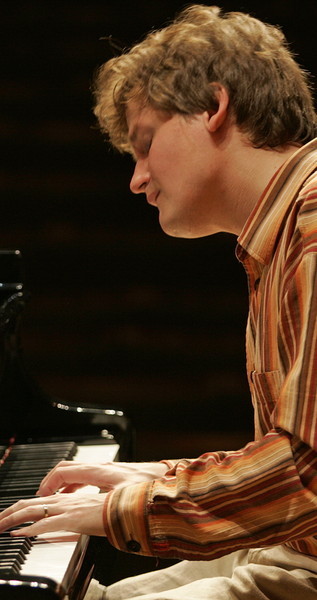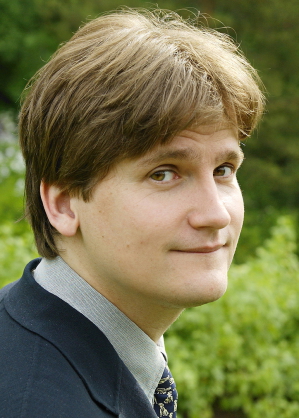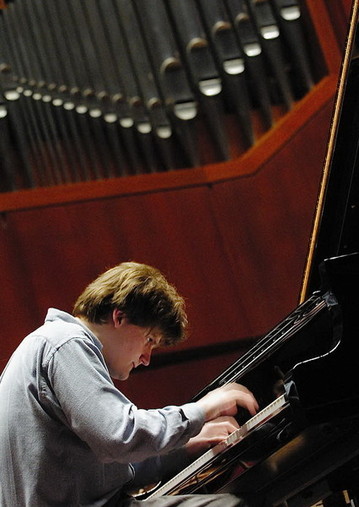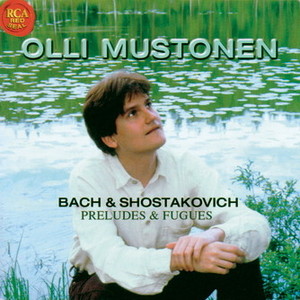
Interview with Pianist Olli Mustonen
by Peter Schlueer, Klassik Heute Magazine
Worlds of Ice and Snow
In fascinatingly eloquent and imaginative ways Finnish pianist and composer Olli Mustonen gives insight into the philosophy of his highly original piano playing, which is founded in a creative and greatly reflective conception of music. In his new recording (see CD review below), he uses a self-invented pattern of intertwining the Preludes and Fugues by Bach - which are arranged chromatically - with the Preludes and Fugues by Shostakovich, which are traveling around the circle of fifths. With that he not only has opened an original gateway to the mathematical beauty of harmony. With his highly individual piano technique he also found a way of interpreting Bach utilizing all expressive means of the modern concert grand without the slightest trace of romanticizing: A radically new pianistic approach to Bach. In the following interview with Peter Schlueer, Mustonen illustrates his artistic intellectual world.
Peter Schlueer: On your new CD you have combined the Preludes and Fugues of Bach and Shostakovich using a unique logical pattern. How did this fascinating idea come to you?
Olli Mustonen: My father is a professional mathematician, a statistician. As a child I learned of phenomena occurring with very simple numbers that look like coincidences, but they are actually not random. I love this beauty and simplicity. This also applies to my combination idea. I felt that I had to find a logical principle, because taking individual pieces from the two cycles simply for reasons of taste would have been unsatisfactory...
Peter Schlueer: ... because the cycles cohere in great logic...
Olli Mustonen: Right, and because we know how much Bach and Shostakovich loved to play with numbers. They would certainly have been interested in such experiments. After all there is a very intimate relationship between music and mathematics: music is in some ways the most abstract of the arts, and mathematics is the most abstract of the sciences.
Peter Schlueer: Bach and Shostakovich, two players of numbers games, but also two very different composers...
Olli Mustonen: To me they are like two giant mountain peaks. There are of course major elements of contrast between two composers from such different eras and countries, but at this enormous level of genius the similarities between them ultimately are greater than the similarities they each share with their respective contemporaries, despite the centuries dividing the two: If in spirit you put yourself on top of a mountain peak in the Himalayas, and simultaneously another one in the Andes, then the differences of what happens in each of the valleys at sea level are huge. They are different worlds. But if you are on the mountain tops at 29,000 feet, then you experience two very similar white worlds of ice and snow.
Peter Schlueer: A great imagery - with which one could also associate your sometimes downright glistening piano sound. When observing you playing the piano, one gets the impression that you have found a highly individual approach to the physical aspects of playing the piano.
Olli Mustonen: There are some principles which are very important to me. Sometimes I teach master classes and have to verbalize these things. It's very interesting. Many pianists believe, for example, that for wide jumps you should keep the hands as flat as possible above the keyboard, in order to have the shortest possible and most economical path. But my feeling is that this is a very tense and unnatural way of playing. It requires very angular movements. If instead you overcome the distance by describing a high arch with your hands, then, while this is a longer path mathematically, it practically is shorter and more natural, since it is a single harmonic motion. The movement becomes part of the sound.
Piano Keyboard Games with Imaginary Numbers
Peter Schlueer: So, consciously taking into account the space above the keyboard is helpful in terms of the sound and economy of movement?
Olli Mustonen: It's almost like higher mathematics. There are sometimes situations where we normally would have to take a difficult detour, as if walking around a corner, in order to get to the result. But if we use the complex and imaginary numbers, then we can take a shortcut, and it becomes much easier. I think at the piano it's just the same: the two-dimensional surface of the keys is the regular 'playground', until one day you begin to think of the complex, imaginary world above the keys. We can't play up there, there are no keys, just as the imaginary numbers do not exist in reality. But if we use this space, we can find wonderful shortcuts.
Peter Schlueer: ...and find a way toward a relaxed, unconstrained playing technique?
Olli Mustonen: Yes. I don't want to boast about it, but as you may know, many pianists have problems with their hands, cramps, muscle tension, and need to see a doctor. I never had such problems. As a child, I had to find an economical way of playing the pieces written for bigger people than me. And so I developed my own natural solution.
Peter Schlueer: The development of a natural technique is also taught by the London piano teacher Peter Feuchtwanger. Have you heard of him?
Olli Mustonen: Oh yes, I've heard a lot of him. He seems to teach in just this way. This technique also has to do with the character of some far Eastern martial arts, with the way you can concentrate your energy. Many very good students, for example, are not able to strike a key by sweeping down from above without slowing down just before hitting the keyboard. Because it takes a lot of courage to do that. You must already feel the chord you want to play way up there...
Peter Schlueer: ...you must have an absolutely clear idea in your head of the chord to be played. With this technique you achieved an almost dance-like freedom of movement. It sometimes seems as if you would choreograph the music you play with your hands.
Olli Mustonen: Exactly. I completely agree with you when you mention the element of dance. It's like a ballet of hands. The wife of the Russian composer Rodion Shchedrin, Maya Plisetskaya, is a legendary ballerina. I have often talked with her about this aspect. She was particularly famous for the expressive use of her hands. I blush when I say this, but she said that she feels a lot of similarity to what I'm doing, and that made me very proud.
Peter Schlueer: It reminds me of the way Carlos Kleiber conducted. It seems as if he dances for his orchestra and finds an individual movement for each musical phrase.
Olli Mustonen: Absolutely. This is fantastic! In the end we try to reach a state in which something flows through us and the piano, in which we become a medium. I don't want to mystify this, but I feel it quite pristinely: I receive the current of music, and my job is to strengthen it as it flows through me, and to pass it on to the audience. And the whole reason for practicing is to remove the obstacles that prevent the current from flowing. So we practice not to do something, but to make something happen. This is very important.
Peter Schlueer: Is the human voice also playing a role in your pianistic world of imagination?
Olli Mustonen: After all, we pianists only play the beginning of the notes, which is a big difference from singers or string players who really can carry a tune. We are like tennis players who only give an impulse. Therefore, we must mentally follow the entire trajectory of the sound, just like as a tennis ball is flying over the net. You never see a tennis player hitting the ball with a short, jerky movement, which would correspond with playing the piano with your hands flat above the keyboard. No, they prepare the stroke by taking a big swing. They virtually live with the ball, and after the impact they let the racket swing out. If we play the piano like this, then a miracle happens: The sounds carry on in the space above the keys just like the balls fly over the net. And only sometimes we hit the ground, to give an impulse, to send another note away toward its next touchdown. In this way we can experience the music as continuous.
Encrypted Secret Messages
Peter Schlueer: You play your current program from the score. Why?
Olli Mustonen: The sight of a Bach fugue in the score is of wonderful clarity and purity, it tremendously inspires me. We have to remember that at first there was only the music without any notation. Our present system of notation developed only very gradually. All over the world there are highly significant musical cultures, but our Western music has experienced an extraordinary blossom in the last few centuries, a miracle. What brought that about? Why did we get so far beyond the original folk music? I think it's because of the phenomenal notation system we discovered. It's fantastically precise and inspiring, a kind of encrypted secret message from one good musician to another. One must be able to read between the lines and notes. In the past, it was customary to play from sheet music, and the audience was amazed when Franz Liszt began to play from memory. It was considered as a lack of respect toward the composer. It's actually very strange that nowadays any pianist is expected to play from memory.
Peter Schlueer: Do you still remember when you learned how to read music?
Olli Mustonen: I remember it very well! It was during my second harpsichord lesson, when I was five years old. With one precise stroke it all of a sudden fit together: the note on the sheet, the key on the instrument, and the emerging sound – one three-dimensional image. And there I had found the key to the riches of our western music. I believe that very evening I played through the entire 'Notenbüchlein für Anna Magdalena Bach', and my parents were a little surprised.
Peter Schlueer: Do you see yourself more as a composer or as a pianist?
Olli Mustonen: Absolutely both. And I really love the word 'musician'. For me it means to be a composer, pianist, conductor, and teacher. Only in the last century these activities began to split into separate professions. I think that's one of the unfortunate reasons why neither in the compositional nor the instrumental field anything particularly interesting happened in the past 30 years. There was not enough interaction between composers and instrumentalists. It's very dangerous for a pianist to lose the awareness of the creative process of composing. A pianist who has never met a composer does not understand how they are thinking, and that's very bad. Even if you are very talented, you will then only be something like a craftsman. The same applies to composers: they become scientists in their laboratories developing their theories, and they don't see what happens when these theories are confronted with real life. Composers, instrumentalists, conductors, teachers, all of them should be 'musicians'.
Finnish Orpheus
Peter Schlueer: Why do so many amazing musical talents emerge from your home country, Finland, for example the conductors Esa-Pekka Salonen, Leif Segerstam, and Paavo Berglund, or composers such as your teacher Einojuhani Rautavaara?
Olli Mustonen: For this I have two somewhat strange theories, which nevertheless are both very important to me. The first one has to do with our language. It is characterized by a very strong rhythm and very clear colors of the vowels. My good friend and colleague Jukka-Pekka Saraste, for example, has a very rhythmic sounding name if you pronounce it correctly. So via our own language we Finns establish a clearly defined sense of rhythm and vocal colorings from very early on. The ear is being very well trained. This phenomenon of course could only blossom after leading figures such as Sibelius had guided the Finnish music culture out of its amateurism.
Peter Schlueer: And your second theory?
Olli Mustonen: It has to do with the Finnish mythology, which until well into this last century has been handed down by the great Finnish poem singers. Sibelius was deeply fascinated by this art of storytelling and singing, and his work is influenced by it, even though he later denied it. This mythical tradition is maybe somewhat more alive in the Finnish people than anywhere else; people more immediately feel the originating of culture from nature. When you make music, play Beethoven for example, then you get in touch with a great force of nature, you become part of something much greater than yourself. And this connection to the 'origin' is a fundamental prerequisite for the vibrancy of music. There is a fascinating Finnish Orpheus myth of music: The hero catches a giant fish in a big lake and kills it. From its bones, he builds a musical instrument. When he plays it, all the animals of the forest come forth to listen to him, drawn by the elemental power of music.
Peter Schlueer
LinkedIn
Original published German version of this Olli Mustonen interview at Klassik Heute Magazine
Olli Mustonen's Recording of the Preludes and Fugues by Bach and Shostakovich
Johann Sebastian Bach arranged his two cycles of 24 Preludes and Fugues of the Well-Tempered Clavier by following the chromatic sequence of keys, i.e. C major, C minor, C sharp major, C sharp minor... Shostakovich however, in his 24 Preludes and Fugues, Op 87 travels around the harmonic circle of fifths, i.e. C major, A minor, G major, E minor... Shostakovich's cycle represents an intensely personal confrontation, a dialogue with Bach's Well-Tempered Clavier. With a congenial discovery, Finnish pianist Olli Mustonen managed to intermix and contrast the first part of the Well-Tempered Clavier with Shostakovich's Preludes and Fugues in a most elegant and absolutely logical sequence of pieces performed.
The first part of this intertwining sequence is presented on above double CD. At first glance, Mustonen tears apart Shostakovich's circle of fifths principle: He subordinates it to the chromatic principle of Bach by following up Bach's C Major Prelude and Fugue with Shostakovich's Prelude and Fugue No. 20 in C minor, No. 15 in D flat major, and No. 10 in C sharp minor, then followed by three Bach Preludes and Fugues, so as to continually ascend in alternating groups of three traveling up the chromatic scale.
The 'kicker' of Mustonen's idea only fully comes to light when we take a look at the second CD set and understand how this sequencing formula plays out here: Mustonen now reversely subordinates the principle of Bach's chromatic sequence of keys to the circle of fifths order of Shostakovich by starting with Shostakovich's C major Prelude and Fugue, followed by Bach's No. 20 in A minor, No. 15 in G major, and No. 10 in E minor, then followed by three Shostakovich Preludes and Fugues, so as to continually ascend in alternating groups of three, this time traveling around the circle of fifths.
In summary this elegant, symmetrical plan traverses both cycles completely, and both systems of order intertwine perfectly. As Mustonen himself puts it, "the two modulation spirals almost miraculously fulfill one another": An example for the fact that music is the most mathematical of the Arts, and at the same time a tribute to the number symbolists Bach and Shostakovich.
This congenial grasp of musical structure corresponds most surprisingly with Mustonen's downright revolutionary playing. Instead of restricting his dynamics to make space for Bach's linear texturing, like everyone before him did, Mustonen no less than reinvents piano playing: making use of all dynamic resources of the modern concert grand he lets Bach's polyphony become perfectly transparent and makes it glisten in an unprecedented light. In a magnificent way, Olli Mustonen, son of a mathematician, is capable of giving a transparency to Bach's four-part fugues, to create a wealth of free breathing space between individual voices, as if a string quartet were playing. An almost dance-like access to Bach; the interpretation of a trapeze artist of the piano, which probably would have put Glenn Gould in astonishment. It seems as if Mustonen put wings on Bach's contrapuntal compactness.
His percussive, airy, glistening tone effortlessly skips the gap between the composers, builds a bridge from peak to peak across the vast valley of time; and a fantastical, in-depth dialogue emerges between two grand masters of counterpoint.
With this recording Mustonen has definitely played himself into the Olympus of pianists.
Peter Schlueer







